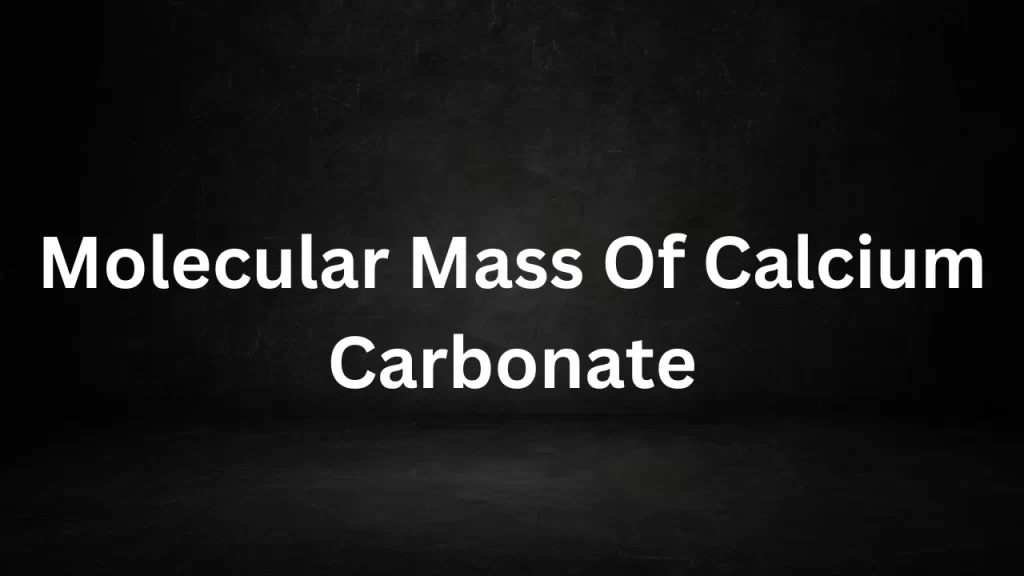Tag: mw of calcium carbonate
Molecular Mass Of Calcium Carbonate
Molecular Mass Of Calcium Carbonate: The molecular mass of calcium carbonate, often referred to as calcium carbonate’s molar mass, is a fundamental concept in chemistry.
It plays a crucial role in various scientific fields, including chemistry, geology, environmental science, and industry. In this article, we will explore what the molecular mass of calcium carbonate is, how it is calculated, its significance, and its practical applications.

Molecular Mass Of Calcium Carbonate
Defining Molecular Mass
The molecular mass, also known as molar mass, of a compound is the mass of one mole of that substance expressed in grams per mole (g/mol). In the case of calcium carbonate (CaCO3), its molecular mass represents the combined mass of one mole of calcium (Ca) atoms, one mole of carbon (C) atoms, and three moles of oxygen (O) atoms.
Calculation of Molecular Mass
To calculate the mole mass of calcium carbonate (CaCO3), we sum the atomic masses of its constituent elements:
- Calcium (Ca): Atomic mass ≈ 40.08 g/mol
- Carbon (C): Atomic mass ≈ 12.01 g/mol
- Oxygen (O): Atomic mass ≈ 16.00 g/mol
Now, let’s calculate the mole mass of CaCO3:
Molecular Mass of CaCO3 = (Molar Mass of Ca) + (Molar Mass of C) + (3 × Molar Mass of O)
The Molecular Mass of CaCO3 = (40.08 g/mol) + (12.01 g/mol) + (3 × 16.00 g/mol)
Molecular Mass of CaCO3 ≈ 100.09 g/mol
Therefore, the mole mass of calcium carbonate (CaCO3) is approximately 100.09 grams per mole.
Significance in Chemistry
- Stoichiometry: The mole mass of calcium carbonate is fundamental in stoichiometry, allowing chemists to calculate the quantities of reactants and products in chemical reactions involving CaCO3.
- Formulation Chemistry: It is important in industries like agriculture and pharmaceuticals for formulating products that contain calcium carbonate.
- Environmental Science: Knowledge of the molecular mass of CaCO3 is essential for understanding its role in environmental processes, such as the dissolution of limestone in natural waters.
Real-World Applications
- Geology: The mole mass of calcium carbonate is crucial in geological studies, where it helps identify and quantify carbonate minerals in rocks and sediments.
- Agriculture: Calcium carbonate is commonly used as a soil conditioner and in the formulation of agricultural products, benefiting from its mole mass calculations.
- Pharmaceuticals: It finds applications in antacids and calcium supplements, where the molecular mass influences dosages and formulations.
- Environmental Monitoring: Understanding the mole mass is important for analyzing the presence and concentration of calcium carbonate in natural water bodies, which can affect water quality and aquatic life.
Conclusion
The mole mass of calcium carbonate (CaCO3), approximately 100.09 g/mol, is a foundational concept in chemistry with broad-reaching implications. It serves as a cornerstone in stoichiometry, formulating various industrial products, and understanding environmental processes. Additionally, its significance extends to geological studies, agriculture, pharmaceuticals, and environmental monitoring. An in-depth comprehension of the mole mass of calcium carbonate is not only essential for scientific research but also for addressing practical challenges in diverse fields.
Read More
- Molar Mass Of Carbon Dioxide
- Difference Between Force And Momentum
- Law Of Conservation Of Linear Momentum
- Molecular Weight Of MgSO4
- Molecular Weight Of H3PO4
Frequently Asked Questions (FAQs) On Molecular Mass Of Calcium Carbonate
1. What is the molecular mass of calcium carbonate (CaCO3)?
The mole mass of calcium carbonate (CaCO3) is approximately 100.09 grams per mole (g/mol).
2. How is the molecular mass of calcium carbonate calculated?
To calculate the molecular mass of CaCO3, you sum the atomic masses of its constituent elements: calcium (Ca), carbon (C), and oxygen (O).
3. What is the atomic mass of calcium (Ca)?
The atomic mass of calcium is approximately 40.08 g/mol.
4. What is the atomic mass of carbon (C)?
The atomic mass of carbon is approximately 12.01 g/mol.
5. What is the atomic mass of oxygen (O)?
The atomic mass of oxygen is approximately 16.00 g/mol.